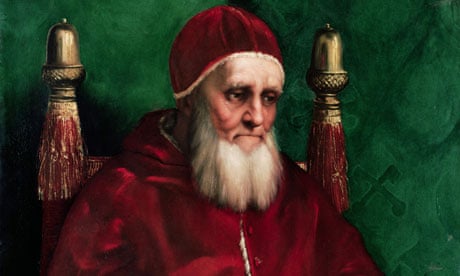What qualities should the cardinal electors be looking for in the next pope? Today's troubled Catholic church needs a charismatic leader, a great pope, to get it out of what surely amounts to a historic crisis. Portraits of some of the greatest popes in history may offer clues to what is needed.
Papal portraiture is a unique genre of art. A portrait of a pope is almost always sedentary. It is a study of old age. It is also an analysis of power, an essay in authority. This strange combination of qualities has made for some of the greatest portraits in the history of art.
The other reason for the excellent quality of popes' portraits is that the period of the Renaissance and baroque from the 15th to 17th centuries brought together some of the most brilliant popes ever to sit on the throne of St Peter, with some of history's supreme artists. The Vatican was the most lavish patron of Italian art in its golden age, and the popes led a cultural Renaissance.
Sixtus IV was portrayed by Melozzo dal Forli sitting on his throne among a gathering of intellectuals. In the picture he is honouring a Renaissance humanist – a scholar of classical antiquity – for his brilliance. The painting has a classical frieze-like style, evoking ancient Roman buildings as it portrays Pope Sixtus as a benign patron of culture. Sixtus was just that – he built the Sistine Chapel (hence its name), where the new pope is being elected. Does that mean the new pope should be someone like Sixtus IV – an intellectual who can negotiate all the doctrinal challenges facing the modern church?
Or do they need a bruiser like Julius II? In his portrait by Raphael in London's National Gallery, this famous pope – painted from life in 1511 – looks tender and meditative. Actually, Julius was violent, irritable and had a short attention span. He regularly threatened to throw people in the Tiber, and supposedly threatened to have his men push Michelangelo off his scaffolding in the Sistine Chapel. Julius led his own armies to wars that he started at the drop of a hat. But he was a patron of genius – he commissioned Michelangelo's Sistine ceiling, Raphael's frescoes in the pope's apartments, and got the architect Bramante to start work on a new St Peter's that eventually became the building we see today.
Julius was a great pope – does that mean the new one should be a warrior who will fight for the honour of the church while lavishing its money on art?
Probably not. Perhaps these historic popes, who ruled like princes, have little to teach a modern religious leader. Does that mean the papacy itself is an institution as irrelevant to modern life as the Doge of Venice?
Pope Innocent X would disagree – look at him glaring out of his portrait by Velázquez, a ruddy character who is totally conscious of his secular power. If Raphael reinvented Julius as a man of inner profundity, Velázquez portrays Innocent as ... anything but innocent. The message here is that a pope needs to be a strong man in a troubled world.
Yet this portrait of Innocent X by Velázquez inspired some of the darkest images of human impotence and tragicomic failure in modern art. Francis Bacon was fascinated by it. His paintings based on it transfigure Innocent's enthroned majesty into a screaming pope paralysed in his seat and enclosed in a railed cell, as if he were a criminal on trial.
The might of the Catholic church belongs to another age. Bacon's portrait is much more accurate to the current plight of the papacy. Facing unprecedented criticism and scandal, the new pope may well feel like screaming.

Comments (…)
Sign in or create your Guardian account to join the discussion